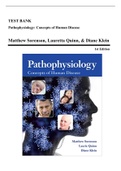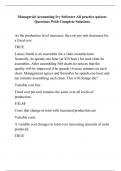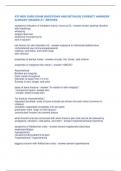TEST BANK
Pathophysiology: Concepts of Human Disease
Matthew Sorenson, Lauretta Quinn, & Diane Klein
1st Edition Table of Contents
Chapter 1 Introduction to the Basics of Pathophysiology 1
Chapter 2 Genetics, Genomics, and Epigenomics 21
Chapter 3 Environmental Health Influences on Disease and Injury 41
Chapter 4 Stress and Adaptation 61
Chapter 5 Health Risks of Obesity and Physical Inactivity 81
Chapter 6 Risks Related to Substance Use Disorders 102
Chapter 7 Risks Related to Sleep Alterations 122
Chapter 8 Fluid and Electrolyte Imbalances 142
Chapter 9 Acid-Base Imbalances 162
Chapter 10 Mechanisms of Cell Injury and Aging 182
Chapter 11 Inflammation 202
Chapter 12 Neoplasia 222
Chapter 13 Mechanisms of Infection and Host Protection 242
Chapter 14 Hypersensitivity and Autoimmune Disorders 262
Chapter 15 Immunodeficiency Disorders 283
Chapter 16 Disorders of White Blood Cells 304
Chapter 17 Restrictive Lung Disorders 324
Chapter 18 Obstructive Lung Disorders 345
Chapter 19 Neoplastic, Infectious, and Pulmonary Vascular Respiratory Disorders 365
Chapter 20 Respiratory Failure 385
Chapter 21 Disorders of Oxygen Transport 405
Chapter 22 Alterations of Hemostasis 425
Chapter 23 Vascular Disorders 445
Chapter 24 Coronary Circulation Disorders 465
Chapter 25 Cardiac Structural Disorders 485
Chapter 26 Heart Failure 505
Chapter 27 Disorders of Circulation Within the CNS 525
Chapter 28 Shock and Multiple Organ Dysfunction Syndrome 545
Chapter 29 Emotional Regulation and Mood 565
Chapter 30 Neurocognitive and Neurodevelopmental Disorders 585
Chapter 31 Disorders of Hearing, Balance, and Vision 605
Chapter 32 Pain, Neuropathy, and Headache 625
Chapter 33 Disorders of Thermoregulation 645
Chapter 34 Disorders Affecting Motor Function 665
Chapter 35 Acute Musculoskeletal Disorders 685
Chapter 36 Chronic Musculoskeletal Disorders 705
Chapter 37 Diabetes Mellitus and Its Complications 725
Chapter 38 Thyroid, Parathyroid, and Adrenal Disorders 745 https://www.stuvia.com/en-us/user/AllStudyGuidesChapter 39 Tissue and Wound Healing 768
Chapter 40 Acute Skin Disorders 788
Chapter 41 Chronic Skin Disorders 808
Chapter 42 Disorders of Upper and Lower Gastrointestinal Systems 828
Chapter 43 Disorders of the Exocrine Pancreatic and Hepatobiliary Systems 848
Chapter 44 Liver Failure 868
Chapter 45 Disorders of Kidney and Urinary Tract Function 888
Chapter 46 Acute Kidney Injury and Chronic Kidney Disease 908
Chapter 47 Disorders of the Female Reproductive System 928
Chapter 48 Disorders of the Male Reproductive System 948
Chapter 49 Sexually Transmitted Infections 968
Chapter 50 Mechanisms of Traumatic Injury 988
Chapter 51 The Pathophysiology of Primary and Secondary Traumatic Injury 1008
Chapter 52 Biologic, Chemical, and Radiologic Agents of Disease 1028
Chapter 53 Pathophysiology at the End of Life 1048 https://www.stuvia.com/en-us/user/AllStudyGuides Pathophysiology: Concepts of Human Disease (Sorenson) Chapter 1 Introduction to the Basics of Pathophys iology 1) Which pathophysiological concept should the nurs e consider when developing a plan of care for a patient with myocardial ischemia? A) There is a decrease in the amount of oxygen and glucose reaching the myocardium. B) There is a lack of oxygen reaching the myocardiu m, but the supply of glucose is adequate. C) There is a lack of glucose reaching the myocardi um, but the supply of oxygen is adequate. D) There is a complete lack of both oxygen and gluc ose reaching the myocardium. Answer: A Explanation: A) A decrease in blood flow to the my ocardium means that there is a decrease in the amount of oxygen and glucose to the heart muscl e. A related term is hypoxia, which refers to a lack of oxygen to tissue. This can occur from dis ruptions of the respiratory system. B) A decrease in blood flow to the myocardium means that there is a decrease in the amount of oxygen and glucose to the heart muscle. A related t erm is hypoxia, which refers to a lack of oxygen to tissue. This can occur from disruptions o f the respiratory system. C) A decrease in blood flow to the myocardium means that there is a decrease in the amount of oxygen and glucose to the heart muscle. A related t erm is hypoxia, which refers to a lack of oxygen to tissue. This can occur from disruptions o f the respiratory system. D) A decrease in blood flow to the myocardium means that there is a decrease in the amount of oxygen and glucose to the heart muscle. A related t erm is hypoxia, which refers to a lack of oxygen to tissue. This can occur from disruptions o f the respiratory system. Page Ref: 7 Cognitive Level: Applying Client Need & Sub: Physiological Integrity: Physio logical Adaptation Standards: Nursing Process: Planning | Learning Ou tcome: 1.1 Define the conceptual basis for and the language used in the study of pathophysiolo gy. | QSEN Competencies: III.A.1. Demonstrate knowledge of basic scientific methods a nd processes | AACN Essential Competencies: IX.8. Implement evidence-based nursin g interventions as appropriate for managing the acute and chronic care of patients and promoting health across the lifespan NLN Competencies: Knowledge and Science: Relations hips between knowledge/science and quality and safe patient care MNL Learning Outcome: LO 1: Recognize the conceptu al basis for and the language used in the study of pathophysiology. ______________________________________________________________________________________________
______________________________________________________________________________________________Test Bank - Pathophysiology: Concepts of Human Disease, 1st Edition (Sorenson, 2019)
1 | P a g e https://www.stuvia.com/en-us/user/AllStudyGuides 2) The nurse is assessing a patient's risk factors for disease at an annual physical examination. Which question would the nurse ask to assess lifest yle risk factors? A) "Does your neighborhood have parks and sidewalks ?" B) "Tell me about the health of your parents." C) "What is the highest level of education that you completed?" D) "How would you describe your diet?" Answer: D Explanation: A) Risk factors emerge from a number of sources. One is the genetic blueprint provided to each of us at birth, and another is lif estyle factors. Lifestyle factors reflect decisions about diet, exercise, smoking, and other variables that influence health. Social determinants of health are factors related to where one lives, educ ational level, income, availability of fresh food, public transportation, and a number of other consid erations that can affect health. B) Risk factors emerge from a number of sources. On e is the genetic blueprint provided to each of us at birth, and another is lifestyle factors. L ifestyle factors reflect decisions about diet, exercise, smoking, and other variables that influen ce health. Social determinants of health are factors related to where one lives, educational lev el, income, availability of fresh food, public transportation, and a number of other consideration s that can affect health. C) Risk factors emerge from a number of sources. On e is the genetic blueprint provided to each of us at birth, and another is lifestyle factors. L ifestyle factors reflect decisions about diet, exercise, smoking, and other variables that influen ce health. Social determinants of health are factors related to where one lives, educational lev el, income, availability of fresh food, public transportation, and a number of other consideration s that can affect health. D) Risk factors emerge from a number of sources. On e is the genetic blueprint provided to each of us at birth, and another is lifestyle factors. L ifestyle factors reflect decisions about diet, exercise, smoking, and other variables that influen ce health. Social determinants of health are factors related to where one lives, educational lev el, income, availability of fresh food, public transportation, and a number of other consideration s that can affect health. Page Ref: 9 Cognitive Level: Applying Client Need & Sub: Health Promotion and Maintenanc e Standards: Nursing Process: Assessment | Learning Outcome: 1.2 Describe characteristics of and risk factors associated with health and illness . | QSEN Competencies: I.B.10 Engage patients or designated surrogates in active partnerships tha t promote health, safety and well-being, and self-care management | AACN Essential Competencies: IX. 1. 1. Conduct comprehensive and focused physical, behavioral, psychological, spirit ual, socioeconomic, and environmental assessments of health and illness parameters in pat ients, using developmentally and culturally appropriate approaches NLN Competencies: Knowledge and Science: Relations hips between knowledge/science and quality and safe patient care MNL Learning Outcome: LO 2: Consider the character istics of and risk factors associated with health and illness. ______________________________________________________________________________________________
______________________________________________________________________________________________Test Bank - Pathophysiology: Concepts of Human Disease, 1st Edition (Sorenson, 2019)
2 | P a g e https://www.stuvia.com/en-us/user/AllStudyGuides 3) The occupational health nurse is assessing a man ufacturing plant for chemical agents that may cause disease in the employees. The nurse should be alert for: A) stress levels. B) helminths. C) radiation. D) lead. Answer: D Explanation: A) Endogenous disease etiologies aris e from within the body. Examples are abnormal immune reactions, gene mutations, coagulat ion defects, stress, and metabolic abnormalities. B) Etiologic agents may be exogenous, that is, aris ing from the external environment, such as chemical, physical, and infectious agents. Examples of infectious etiologic agents are bacteria, viruses, fungi, and helminths. C) Etiologic agents may be exogenous, that is, aris ing from the external environment, such as chemical, physical, and infectious agents. Examples of physical etiologic agents are extremes in environmental temperatures, radiation, trauma, and electricity. D) Etiologic agents may be exogenous, that is, aris ing from the external environment, such as chemical, physical, and infectious agents. Examples of chemical etiologic agents are alcohol, lead, mercury, air pollutants, carbon monoxide, pes ticides, and adverse effects of medications. Page Ref: 10 Cognitive Level: Applying Client Need & Sub: Health Promotion and Maintenanc e Standards: Nursing Process: Assessment | Learning Outcome: 1.3 Outline the structure of this program, including the pathogenesis and etiology of disease; the clinical manifestations of disorders; how pathophysiology is linked to diagnos is and treatment; and the impact of genetics, nutrition, and lifespan on health and illness. | QS EN Competencies: III.A.1. Demonstrate knowledge of basic scientific methods and processes | AACN Essential Competencies: IX. 1. 1. Conduct comprehensive and focused physical, behavio ral, psychological, spiritual, socioeconomic, and environmental assessments of hea lth and illness parameters in patients, using developmentally and culturally appropriate ap proaches NLN Competencies: Knowledge and Science: Relations hips between knowledge/science and quality and safe patient care MNL Learning Outcome: LO 2: Consider the character istics of and risk factors associated with health and illness. ______________________________________________________________________________________________
______________________________________________________________________________________________Test Bank - Pathophysiology: Concepts of Human Disease, 1st Edition (Sorenson, 2019)
3 | P a g e https://www.stuvia.com/en-us/user/AllStudyGuides 4) A patient has been diagnosed with idiopathic pul monary fibrosis. The nurse explains to the patient that idiopathic means: A) the disease is inherited. B) the cause is unknown. C) it was caused by an error in care. D) the disease is secondary to another illness. Answer: B Explanation: A) A disease that is inherited is a g enetic or hereditary disorder. B) When the cause of a disease cannot be determined , its etiology is said to be idiopathic. C) The etiology of conditions that are caused unint entionally by a treatment, a diagnostic procedure, or an error caused by a healthcare provi der are called iatrogenic. D) A condition that is caused by another disease is called a secondary disorder. Page Ref: 10 Cognitive Level: Understanding Client Need & Sub: Physiological Integrity: Physio logical Adaptation Standards: Nursing Process: Implementation | Learn ing Outcome: 1.3 Outline the structure of this program, including the pathogenesis and etiolo gy of disease; the clinical manifestations of disorders; how pathophysiology is linked to diagnos is and treatment; and the impact of genetics, nutrition, and lifespan on health and illness. | QS EN Competencies: III.A.1. Demonstrate knowledge of basic scientific methods and processes | AACN Essential Competencies: IX.7. Provide appropriate patient teaching that reflects developmental stage, age, culture, spirituality, patient preferences, and health literacy considerat ions to foster patient engagement in their care NLN Competencies: Knowledge and Science: Relations hips between knowledge/science and quality and safe patient care MNL Learning Outcome: LO 3: Relate how the key fac tors and basic principles that inform pathophysiology impact health and illness. ______________________________________________________________________________________________
______________________________________________________________________________________________Test Bank - Pathophysiology: Concepts of Human Disease, 1st Edition (Sorenson, 2019)
4 | P a g e https://www.stuvia.com/en-us/user/AllStudyGuides 5) The nurse is documenting the assessment findings from a patient being seen in the clinic. Which of the following does the nurse document as a subjective finding? A) Nausea B) Breath sounds C) Fever D) Skin color Answer: A Explanation: A) A symptom is a subjective sensatio n that is perceived by the affected individual but not observable by the person examining the indi vidual. Examples of symptoms include pain, nausea, dyspnea, and numbness. A sign is an objecti ve indication of disease that is observable by the person conducting a physical assessment. Exampl es of signs include abnormal heart or lung sounds, rash, fever, a change in the respiratory or heart rate, sluggish or absent pupil reaction to light, and changes in skin color. B) A symptom is a subjective sensation that is perc eived by the affected individual but not observable by the person examining the individual. Examples of symptoms include pain, nausea, dyspnea, and numbness. A sign is an objective indic ation of disease that is observable by the person conducting a physical assessment. Examples o f signs include abnormal heart or lung sounds, rash, fever, a change in the respiratory or heart rate, sluggish or absent pupil reaction to light, and changes in skin color. C) A symptom is a subjective sensation that is perc eived by the affected individual but not observable by the person examining the individual. Examples of symptoms include pain, nausea, dyspnea, and numbness. A sign is an objective indic ation of disease that is observable by the person conducting a physical assessment. Examples o f signs include abnormal heart or lung sounds, rash, fever, a change in the respiratory or heart rate, sluggish or absent pupil reaction to light, and changes in skin color. D) A symptom is a subjective sensation that is perc eived by the affected individual but not observable by the person examining the individual. Examples of symptoms include pain, nausea, dyspnea, and numbness. A sign is an objective indic ation of disease that is observable by the person conducting a physical assessment. Examples o f signs include abnormal heart or lung sounds, rash, fever, a change in the respiratory or heart rate, sluggish or absent pupil reaction to light, and changes in skin color. Page Ref: 10 Cognitive Level: Applying Client Need & Sub: Physiological Integrity: Physio logical Adaptation Standards: Nursing Process: Assessment | Learning Outcome: 1.3 Outline the structure of this program, including the pathogenesis and etiology of disease; the clinical manifestations of disorders; how pathophysiology is linked to diagnos is and treatment; and the impact of genetics, nutrition, and lifespan on health and illness. | QS EN Competencies: III.A.1. Demonstrate knowledge of basic scientific methods and processes | AACN Essential Competencies: IX. 1. 1. Conduct comprehensive and focused physical, behavio ral, psychological, spiritual, socioeconomic, and environmental assessments of hea lth and illness parameters in patients, using developmentally and culturally appropriate ap proaches NLN Competencies: Knowledge and Science: Relations hips between knowledge/science and quality and safe patient care MNL Learning Outcome: LO 1: Recognize the conceptu al basis for and the language used in the study of pathophysiology. ______________________________________________________________________________________________
______________________________________________________________________________________________Test Bank - Pathophysiology: Concepts of Human Disease, 1st Edition (Sorenson, 2019)
5 | P a g e






